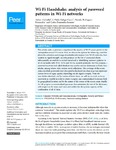Wi-Fi Handshake: analysis of password patterns in Wi-Fi networks

Ver/
Use este enlace para citar
http://hdl.handle.net/2183/32723
A non ser que se indique outra cousa, a licenza do ítem descríbese como Atribución 4.0 International (CC BY 4.0)
Coleccións
- Investigación (FIC) [1728]
Metadatos
Mostrar o rexistro completo do ítemTítulo
Wi-Fi Handshake: analysis of password patterns in Wi-Fi networksAutor(es)
Data
2022Cita bibliográfica
Carballal A, Galego-Carro JP, Rodriguez-Fernandez N, Fernandez-Lozano C. 2022. Wi-Fi Handshake: analysis of password patterns in Wi-Fi networks. PeerJ Computer Science 8:e1185. Disponible: https://doi.org/10.7717/peerj-cs.1185
Resumo
[Abstract]: This article seeks to provide a snapshot of the security of Wi-Fi access points in the metropolitan area of A Coruña. First, we discuss the options for obtaining a tool that allows the collection and storage of auditable information from Wi-Fi networks, from location to signal strength, security protocol or the list of connected clients. Subsequently, an analysis is carried out aimed at identifying password patterns in Wi-Fi networks with WEP, WPA and WPA2 security protocols. For this purpose, a password recovery tool called Hashcat was used to execute dictionary or brute force attacks, among others, with various word collections. The coverage of the access points in which passwords were decrypted is displayed on a heat map that represents various levels of signal quality depending on the signal strength. From the handshakes obtained, and by means of brute force, we will try to crack as many passwords as possible in order to create a targeted and contextualized dictionary both by geographical location and by the nature of the owner of the access point. Finally, we will propose a contextualized grammar that minimizes the size of the dictionary with respect to the most used ones and unifies the decryption capacity of the combination of all of them.
Palabras chave
WPA
WPA2
Wi-Fi security
Password cracking
Hashcat
WPA2
Wi-Fi security
Password cracking
Hashcat
Descrición
This work is supported by the General Directorate of Culture, Education and University Management of Xunta de Galicia (Ref. ED431G/01, ED431D 2017/16), the Galician Network for Colorectal Cancer Research (Ref. ED431D 2017/23), Competitive Reference Groups (Ref. ED431C 2018/49) and the Spanish Ministry of Economy and Competitiveness via funding of the unique installation BIOCAI (UNLC08-1E-002, UNLC13-13-3503) and the European Regional Development Funds (FEDER). The funders had no role in study design, data collection and analysis, decision to publish, or preparation of the manuscript.
Versión do editor
Dereitos
Atribución 4.0 International (CC BY 4.0)






